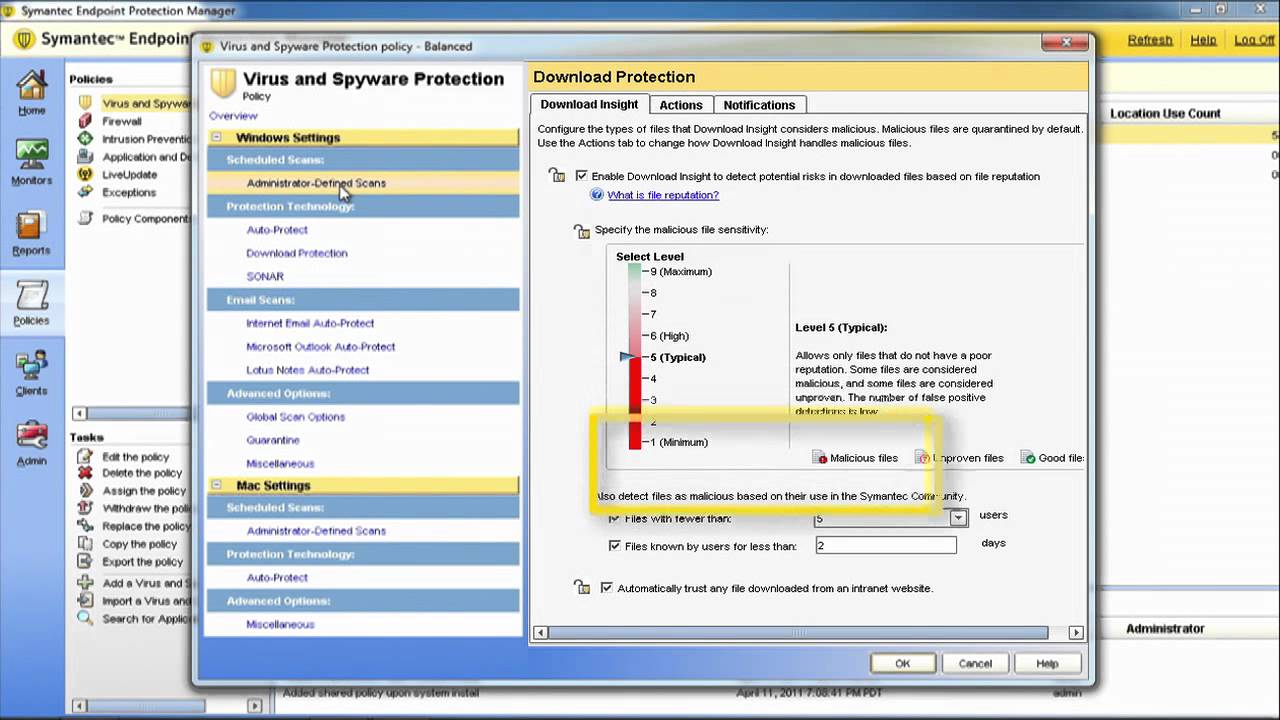

What if I don't want you to manage my antivirus software in this way? For example, don't open any attachments you receive in e-mail unless you know the sender AND know that they were going to send you the attachment (since some viruses spread by sending mail to all addresses in a user's address book). Since even the most current virus definitions can't protect against a brand new virus, you should also plan to continue to be very careful not to expose yourself to any viruses. You should also plan to contact your LSP as soon as possible if you receive any error messages from SAV or SEP or any notifications that a virus was detected but not cleaned. Contact your LSP if you see any problems. Check the data of the Virus Definition File. Double click on the icon to open SAV or SEP.

Ensure that it does not have a red slash mark through it, If it does, then SAV or SEP is not active. To check status, look for the yellow shield icon in the system tray on the bottom right of the screen.

If your machine is operating in managed mode, you should still plan to occasionally check to ensure that your definitions are current and that the antivirus software is loaded and operational. SAS Computing staff monitor the status of all managed mode clients, so as to ensure that virus defintions are not out of date and that the machine continues to stay in contact with the management server. If my machine is managed, what do I still have to do? Security compromise of desktop machines by such programs, which if present can provide someone else with total access to your machine, is a real and growing risk. For one, having up-to-date (and properly configured) antivirus software is one of the best protections against the sort of privacy violations that can take place if a "backdoor" monitoring program is surreptitiously installed on a desktop machine. While the use of SAV and SEP in managed mode may represent a small decrease in privacy, it should be viewed in the context of the advantages it will provide. The file name of an infected file is included in these status messages, but no contents of files are made available by this system. When a virus is detected on a machine, this will be logged centrally and the local computing support provider will receive this informatiom. It does not provide any other level of access to the client. This arrangement will only allow computing staff to manage the antivirus software itself, and to receive status messages from this software. What sort of access to my machine does it provide? If a machine is turned off, it will simply check in with the server when it is next booted up and will obtain any needed updates and configuration changes at that time. Most communication is client initiated, but configuration changes can be sent from the server to the client as well. This allows the desktop client to communicate with the management server. When the SAV and SEP software is installed in managed mode, a management component (based on Intel's LANDesk remote management product) is also installed. In addition, the virus detection reporting features available in managed mode allow computing staff to monitor the presence of viruses on managed machines. This is a hige advantage if a virus outbreak starts, as all managed machines can be updated easily after new defintions are released. Use of managed mode helps to ensure that the antivirus protection is active and properly configured on the managed machines, that virus definitions on these machines are up to date, and allow virus definition updates to be applied automatically without user intervention. This document provides more information regarding the use of SAV and SEP in managed mode and SAS Computing's implementation of this system.
ANTIVIRUS SYMANTEC ENDPOINT PROTECTION WINDOWS
It is the default for all new Windows machines installed by SAS Computing staff. SAS Computing implements SAV and SEP in managed mode for all supported Windows machines which are continuously connected to the ethernet network when in use. SAS Computing has found the use of SAV and SEP in managed mode on Windows machines to be a major advance in the provision of protection from viruses, in that up-to-date protection can be maintained with far less intervention and monitoring being required on the part of the user. This option is only available for Windows machines. SAS Computing will run such a server and it will also be used to provide program and virus definition updates automatically. What this means is that the software installed on a desktop machine can be configured to allow its settings to be managed and monitored from a central server. (This information is for Windows users only)įor Windows machines, where new viruses and virus outbreaks are most common, one of the main advantages of Symantec AntiVirus (SAV) or Symentec Endpoint Protection (SEP) is the ability for the software to be "managed" remotely.


 0 kommentar(er)
0 kommentar(er)
